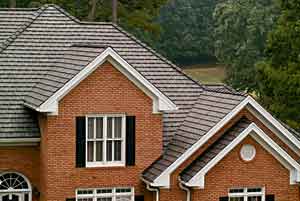Concrete Tiles: Durable, Sustainable Roofing Materials Integrate Design and Performance
Concrete Tile Design Issues
Concrete roof tile is suitable for use in a variety of climates, and reflects tradition, function, and technology. "The roof changes the whole appearance of the outside of a house," says Mac McKinney, president, McKinney Builders, Newnan, Georgia. There are, however, certain design criteria that merit consideration.
Weight: While concrete tile is unequivocally heavier than other roofing materials like asphalt and wood, rarely in single-family home construction does it require special structural accommodation. In new home construction, trusses are pre-designed to support the load of standard weight concrete tiles. When re-roofing an existing home in the West, a lightweight concrete tile is an option at less than six pounds per square foot, which in most municipalities is below the weight necessary for an extra structural engineer's report.
|
Colder climates: The material has in the past enjoyed greater popularity in the southern United States and South Pacific than it has in northern portions of the Western Hemisphere. But concrete tile roofs actually have been mainstays for hundreds of years in the coldest climates in Europe.
Variety of shapes and colors: Concrete tile is often associated with rounded shapes and red tones, as frequently seen in churches and homes in Spain, Mexico, and Southern California. But concrete roof tiles are available in a variety of shapes and colors appropriate for most architectural styles. Concrete tile can be made to look like many other natural materials, such as slate, clay and wood in various shapes and profiles.
Fiber-cement products: Fiber-cement roofing products are made from cement and wood fiber cellulose. Cellulose is an organic material that is susceptible to moisture and resultant deterioration if the cellulose product is not formulated and manufactured properly. Many fiber-cement roofing products have failed or deteriorated more quickly than expected.
Seismic properties: A study commissioned by the National Tile Roofing Manufacturers Association suggests that concrete and clay roof tiles withstand seismic forces far greater than the 0.8g (gravity acceleration) that the Uniform Building Code requires for other building components.
Costs: With the rising cost of petroleum-based products, such as asphalt shingles, concrete tile has become more comparatively priced. When life cycle costs and sustainability are considered, concrete tile is an economical choice. According to the nonprofit Committee for Firesafe Roofing, measured by life cycle costs in 2005, concrete tile averaged approximately six dollars per 100 square feet, compared to 22 dollars for wood shake roofing material, eight dollars for metal, or a comparable six dollars for asphalt or fiberglass heavy laminate shingles.










